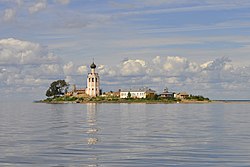Kamenny Monastery

Kamenny Monastery in 2013
|
|
| Monastery information | |
|---|---|
| Order | Orthodox |
| Established | c. 1260 |
| Disestablished | 1925 |
| Diocese | Vologda |
| Site | |
| Location | Vologda, Russia |
| Coordinates | 59°36′27″N 39°34′22″E / 59.60750°N 39.57278°ECoordinates: 59°36′27″N 39°34′22″E / 59.60750°N 39.57278°E |
Kamenny Monastery (Russian: Спасо-Преображенский Свято-Каменный монастырь) was the name of a Russian Orthodox monastery situated on a small eponymous island in the very centre of the Kubensky Lake, in Ust-Kubinsky District of Vologda Oblast, Russia. It is distinguished as the first stone monastery of the Russian North.
Kamenny Island (literally, "Stony Island") is very small, measuring just 120 metres by 70 metres. It is so named after stony ramparts set up by the monks around the island's perimeter in order to preclude its erosion. The lake is known for its inclement weather and frequent storms. The monastery was quite rich, owning seven larger villages (selo), four average villages (seltso) and 98 small villages, in addition to two salt pans in Totma and two branches in Vologda.
It is believed that during one of such storms in 1269 Duke Gleb of Beloozero was cast ashore, where he found a small monastic community. The legends of the monks attribute the construction of the first timber cathedral on the isle to the funds subsequently provided by that monarch.
Under Dmitry Donskoy, the Kamenny Monastery was run by Dionisius, a Greek monk who introduced the coenobian rule of Mount Athos, whereby the brethren were closed alike, took their meals (usually limited to bread and scarce vegetables) in the refectory and were bound to possess no private property. Female animals were banned from the isle to avoid any impure thought on the part of the monks.
The monastic community reached its peak under Paisiy Yaroslavov, a former hegumen of the Trinity Lavra and one of the most influential clerics of the time. This starets authored The Tale of the Kamenny Monastery whose main themes are the history of this monastery and the struggle of its monks against paganism in the area.
In 1476 the monastery burnt down. Ivan III's brother Andrey Menshoy, who was the ruler of Vologda, commissioned a stone four-pillared cathedral to be built on the island. The two-storey two-domed edifice was constructed in 1481 by a team of masters from Rostov, who proceeded to erect very similar cathedrals in the Ferapontov Monastery (1490) and Kirillo-Belozersky Monastery (1497). Paisiy Yaroslavov mentions that he engaged the great artist Dionisius to paint a deesis for the cathedral. It is believed that Dionisius's works perished 185 years later, during a great fire, which resulted in the collapse of the domes.
...
Wikipedia

